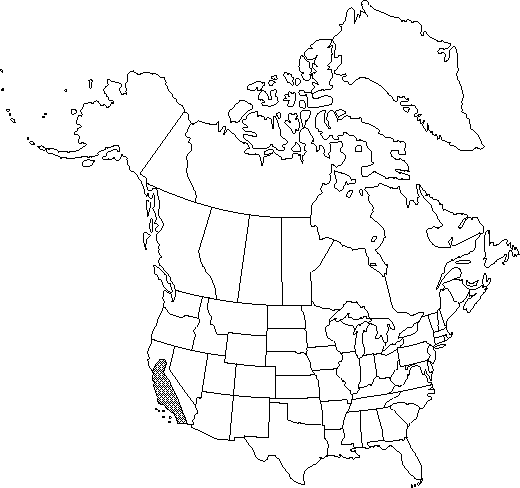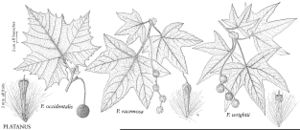Difference between revisions of "Platanus racemosa"
N. Amer. Sylv. 1: 47. 1842.
FNA>Volume Importer |
FNA>Volume Importer |
||
| Line 21: | Line 21: | ||
}}<!-- | }}<!-- | ||
| − | --><span class="statement" id="st- | + | --><span class="statement" id="st-undefined" data-properties=""><b>Trees,</b> to 15(-25) m, rather massive; trunks sometimes straight and erect, more commonly irregular, reclining, or prostrate with branches irregular and sometimes near ground, to 2+m diam. <b>Leaves</b>: stipules entire to somewhat dentate. <b>Leaf</b> blade dark green, 3-5-lobed, 10-25 × 10-25 cm, rather thick; lobes of blade mostly longer than wide, basal lobes usually somewhat smaller and spreading, not reflexed, sinuses broad and deeply concave, depth of distal sinuses about 1/3-2/3 distance from sinus to base of blade, terminal leaf lobe ca. 1/3-2/3 length of blade; margins entire to remotely serrulate, apex acute to acuminate, sometimes rounded; surfaces abaxially persistently tomentose, adaxially glabrescent. <b>Pistillate</b> inflorescences: heads (1-)2-7; fruiting heads 20-25(-30) mm diam., lateral ones sessile; fruiting rachis to 25 cm. <b>Achenes</b> 7-10 mm, basal hairs about 2/3 length of achenes. <b>2n</b> = 42.</span><!-- |
-->{{Treatment/Body | -->{{Treatment/Body | ||
| Line 27: | Line 27: | ||
|habitat=Streamsides and moist, rocky canyons, often abundant | |habitat=Streamsides and moist, rocky canyons, often abundant | ||
|elevation=0-1500 m | |elevation=0-1500 m | ||
| − | |distribution=Calif.;Mexico (Baja California) | + | |distribution=Calif.;Mexico (Baja California). |
|discussion=<p>The Eurasian oriental plane, Platanus orientalis Linnaeus, is sometimes cultivated and would key to this or the next species. It has deeply lobed, serrate leaves resembling Acer saccharinum and A. macrophyllum, and the fruiting rachis bears three to six heads.</p><!-- | |discussion=<p>The Eurasian oriental plane, Platanus orientalis Linnaeus, is sometimes cultivated and would key to this or the next species. It has deeply lobed, serrate leaves resembling Acer saccharinum and A. macrophyllum, and the fruiting rachis bears three to six heads.</p><!-- | ||
--><p>Native Americans used infusions prepared from the plants of Platanus orientalis medicinally as a panacea, and from the bark for indisposition (D. E. Moerman 1986).</p> | --><p>Native Americans used infusions prepared from the plants of Platanus orientalis medicinally as a panacea, and from the bark for indisposition (D. E. Moerman 1986).</p> | ||
| Line 48: | Line 48: | ||
|habitat=Streamsides and moist, rocky canyons, often abundant | |habitat=Streamsides and moist, rocky canyons, often abundant | ||
|elevation=0-1500 m | |elevation=0-1500 m | ||
| − | |distribution=Calif.;Mexico (Baja California) | + | |distribution=Calif.;Mexico (Baja California). |
|reference=None | |reference=None | ||
|publication title=N. Amer. Sylv. | |publication title=N. Amer. Sylv. | ||
|publication year=1842 | |publication year=1842 | ||
|special status=Selected by author to be illustrated | |special status=Selected by author to be illustrated | ||
| − | |source xml=https://jpend@bitbucket.org/aafc-mbb/fna- | + | |source xml=https://jpend@bitbucket.org/aafc-mbb/fna-data-curation.git/src/9216fc802291cd3df363fd52122300479582ede7/coarse_grained_fna_xml/V3/V3_387.xml |
|genus=Platanus | |genus=Platanus | ||
|species=Platanus racemosa | |species=Platanus racemosa | ||
| − | |||
| − | |||
| − | |||
| − | |||
| − | |||
| − | |||
| − | |||
| − | |||
| − | |||
| − | |||
| − | |||
| − | |||
| − | |||
| − | |||
| − | |||
| − | |||
| − | |||
| − | |||
| − | |||
| − | |||
| − | |||
| − | |||
| − | |||
| − | |||
| − | |||
| − | |||
| − | |||
| − | |||
| − | |||
| − | |||
| − | |||
| − | |||
| − | |||
| − | |||
| − | |||
}}<!-- | }}<!-- | ||
-->[[Category:Treatment]][[Category:Platanus]] | -->[[Category:Treatment]][[Category:Platanus]] | ||
Revision as of 13:39, 27 July 2019
Trees, to 15(-25) m, rather massive; trunks sometimes straight and erect, more commonly irregular, reclining, or prostrate with branches irregular and sometimes near ground, to 2+m diam. Leaves: stipules entire to somewhat dentate. Leaf blade dark green, 3-5-lobed, 10-25 × 10-25 cm, rather thick; lobes of blade mostly longer than wide, basal lobes usually somewhat smaller and spreading, not reflexed, sinuses broad and deeply concave, depth of distal sinuses about 1/3-2/3 distance from sinus to base of blade, terminal leaf lobe ca. 1/3-2/3 length of blade; margins entire to remotely serrulate, apex acute to acuminate, sometimes rounded; surfaces abaxially persistently tomentose, adaxially glabrescent. Pistillate inflorescences: heads (1-)2-7; fruiting heads 20-25(-30) mm diam., lateral ones sessile; fruiting rachis to 25 cm. Achenes 7-10 mm, basal hairs about 2/3 length of achenes. 2n = 42.
Phenology: Flowering spring; fruiting late fall.
Habitat: Streamsides and moist, rocky canyons, often abundant
Elevation: 0-1500 m
Distribution

Calif., Mexico (Baja California).
Discussion
The Eurasian oriental plane, Platanus orientalis Linnaeus, is sometimes cultivated and would key to this or the next species. It has deeply lobed, serrate leaves resembling Acer saccharinum and A. macrophyllum, and the fruiting rachis bears three to six heads.
Native Americans used infusions prepared from the plants of Platanus orientalis medicinally as a panacea, and from the bark for indisposition (D. E. Moerman 1986).
Selected References
None.
